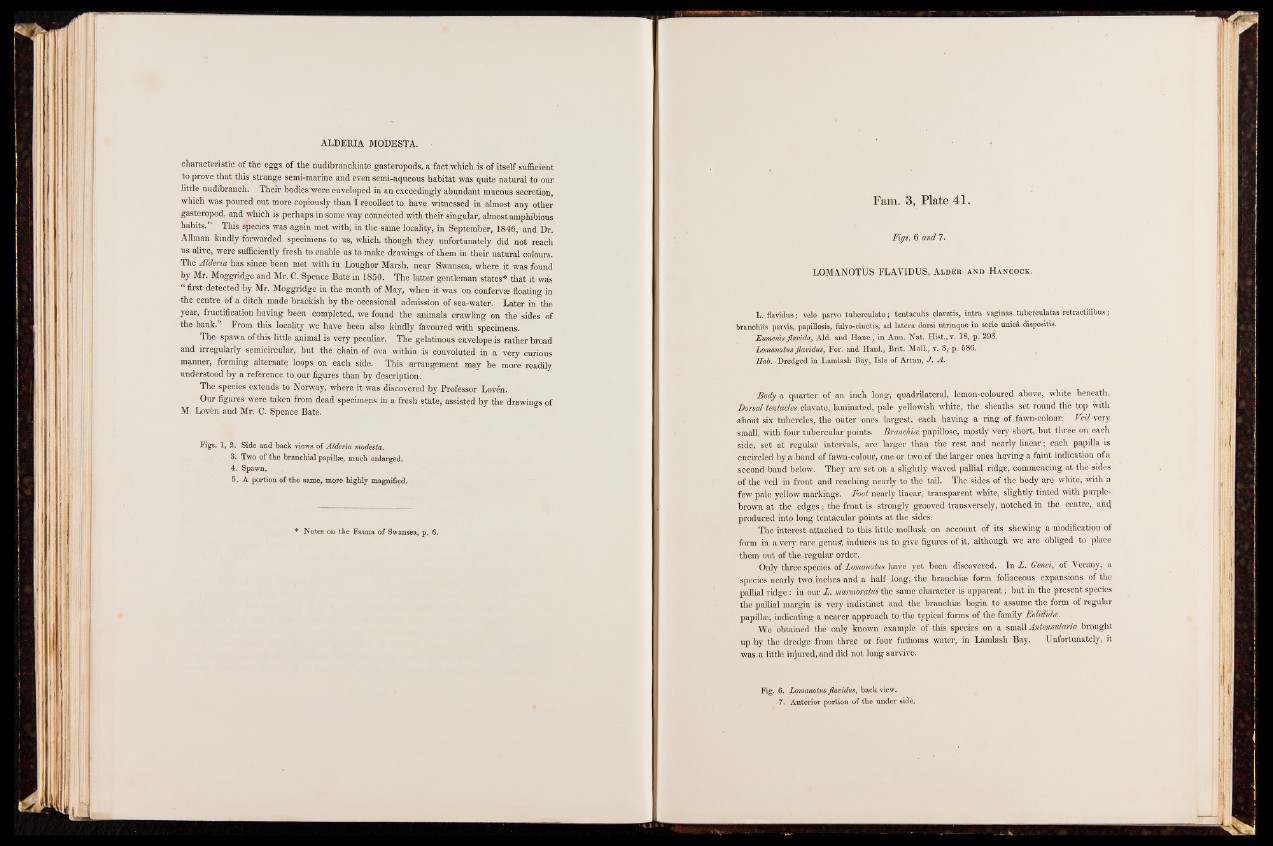
ALDERIA MODESTA.
characteristic of the eggs of the nudibranchiate gasteropods, a fact which is of itself sufficient
to prove that this strange semi-marine and even semi-aqueous habitat was quite natural to our
little nudibranch. Their bodies were enveloped in an exceedingly abundant mucous secretion,
which was poured out more copiously than I recollect to have witnessed in almost any other
gasteropod, and which is perhaps in some way connected with their singular, almost amphibious
habits.” This species was again met with, in the same locality, in September, 1846, and Dr.
Allman kindly forwarded specimens to us, which, though they unfortunately did not reach
us alive, were sufficiently fresh to enable us to make drawings of them in their natural colours.
The Alderia has since been met with in Loughor Marsh, near Swansea, where it was found
by Mr. Moggridge and Mr. C. Spence Bate in 1850. The latter gentleman states* that it was
“ first detected by Mr. Moggridge in the month of May, when it was on conferae floating in
the centre of a ditch made brackish by the occasional admission of sea-water. Later in the
year, fructification having been completed, we found the animals crawling on the sides of
the bank. From this locality we have been also kindly favoured with specimens.
The spawn of this little animal is very peculiar. The gelatinous envelope is rather broad
and irregularly semicircular, but the chain of ova within is convoluted in a very curious
manner, forming alternate loops on each side. This arrangement may be more readily
understood by a reference to our figures than by description.
The species extends to Norway, where it was discovered by Professor Loven.
Our figures were taken from dead specimens in a fresh state, assisted by the drawings of
M. Loven and Mr. C. Spence Bate.
Figs. 1, 2. Side and back views of Alderia modesta.
8. Two of the branchial papillae, much enlarged.
4. Spawn.
5. A portion of the same, more highly magnified.
* Notes on the Fauna of Swansea, p. 6.
Figs. 6 and 7.
LOMANOTUS FLAVIDUS, Alder and Hancock.
L. flavidus j velo parvo tuberculato; tentaculis clavatis, intra vaginas tuberculatas retractilibus;
branchiis parvis, papillosis, fulvo-cinctis, ad latera dorsi utrinque in serie unic& dispositis.
Eumenis flavida, Aid. and Hanc., in Ann. Nat. Hist., v. 18, p. 293.
Lomanotus flavidus, For. and Hanl., Brit. Moll., v. 3, p. 586.
Hab. Dredged in Lamlash Bay, Isle of Arran, J. A.
Body a quarter of an inch long, quadrilateral, lemon-coloured above, white beneath.
Dorsal tentacles clavate, laminated, pale yellowish white, the sheaths set round the top with
about six tubercles, the outer ones largest, each having a ring of fawn-colour. Vril very
small, with four tubercular points. Branchiae papillose, mostly very short, but three on each
side, set at regular intervals, are larger than the rest and nearly linear; each papilla is
encircled by a band of fawn-colour, one or two of the larger ones having a faint indication of a
second band below. They are set on a slightly waved pallial ridge, commencing at the sides
of the veil in front and reaching nearly to the tail. The sides of the body are white, with a
few pale yellow markings. Foot nearly linear, transparent white, slightly tinted with purple-
brown at the edges ; the front is strongly grooved transversely, notched in the centre, ancj
produced into long tentacular points at the sides.
The interest attached to this little mollusk on account of its shewing a modification of
form in a very rare genu^, induces us to give figures of it, although we are obliged to place
them out of the regular order.
Only three species of Lomanotus have yet been discovered. In L. Genei, of Verany, a
species nearly two. inches and a half long, the branchiae form foliaceous expansions of the
pallial ridge: in our L. marmoratus the same character is apparent; but in the present species
the pallial margin is very indistinct and the branchiae begin to assume the form of regular
papillae, indicating a nearer approach to the typical forms of the family Eolidida.
We obtained the only known example of this species on a small Antennularia brought
up by the dredge from three or four fathoms water, in Lamlash Bay. Unfortunately, it
was a little injured, and did not long survive.
Fig. 6. Lomanotus flavidus, back view.
7. Anterior portion of the under side.